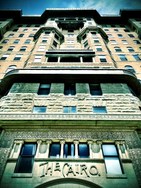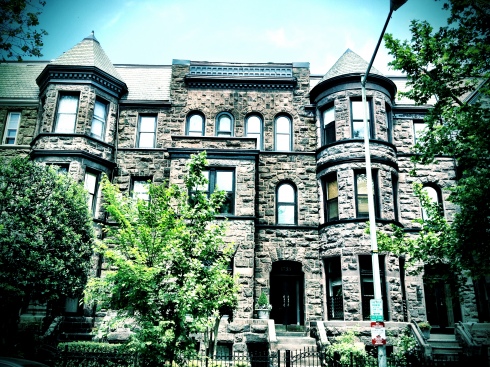The other Schneider: Q Street builder’s murderous brother

The Cairo. Photo by the author.
No discussion or debate about DC’s Height Act is complete without mention of T.F. Schneider’s Cairo Apartment Building on Q Street NW. The 1894 construction of the gorgeous building was the catalyst for the building height restrictions we know and love today.
It is fortuitous for Schneider that the building caused such an impression. He’s lucky that we remember him for this lovely building and for the fantastic tree-lined block of Q Street row-houses between 17th and 18th Streets that he built as a speculative venture for well-to-do families when the area began to thrive. Because we could instead remember T.F. for the chilly murders committed by his crazy brother Howard in 1892 on that same Q Street block or for Howard’s subsequent sensational trial and execution. The Washington Post reported:
It was at 8 o’clock on the evening of Sunday, January 31, 1892, that [Howard J.] Schneider shot his wife, Amanda Hamlink Schneider, and his brother-in-law, Frank Hamlink, almost in front of their father’s door, on [1733] Q Street between Seventeenth and Eighteenth. Schneider was a young electrician when he met Amanda Hamlink, in the summer of 1891. He was of good family, not a bad-looking young fellow, who dressed well and drove fast horses. He made love to the young lady, became engaged to her, and one day in June when they were out driving he produced a marriage license and threatened to shoot himself unless she married him at once. Miss Hamlink yielded, and a minister in Hyattsville performed the ceremony.
The marriage was kept a secret until fall, when the young woman’s father discovered it. Then there was a scene, the father suspecting at first that the marriage had been a fraud, and requiring Schneider to produce the certificate. After that Schneider went to the Hamlink house to live. His cruelties made the life of his wife an unhappy one. More than once he threatened to shoot her. Finally he began staying out late at night, and after due warning was locked out from the Hamlink house.
About this time, a few weeks before the tragedy, he became enamored of a young girl from Virginia who was visiting [her sister who also lived on that same Q Street block]. He determined to secure a divorce from his wife, and made preparations to go to Chicago. On the Sunday evening of the tragedy he had sent a colored man to the house with a note asking if his wife intended to live with him. While he was waiting for an answer across the street from the house, his wife, with her brother and sister, walked down Q Street from Eighteenth. Schneider crossed over to them, leaving his chum, Marion Appleby on the south side of the street. Grasping at his wife roughly by the wrist, he told her he wanted to speak to her. The brother interfered. Schneider drew a revolver and fired five shots. Three of them entered the body of his wife, whom he still held by the hand, one pierced Frank Hamlink’s breast, and the fifth crashed through the window of the Hamlink house.
Frank Hamlink fell into the street, dying almost instantly. Mrs. Schneider was able to walk into the house. She languised until the 6th of February, and left a dying declaration detailing the circumstances of the crime.
Howard Schneider threw down his revolver by the body of Frank Hamlink and fled. Within a half hour he walked into the nearest police station and gave himself up, saying he did the deed in self-defense.
Although most of us have never heard a thing about it, Howard Schneider’s trial was one of the most infamous the city has ever experienced. The Washington Post’s April 10, 1892 edition (the day after the verdict) was the largest edition it had ever published up to that time. 10,000 additional copies and an extra came off the presses.
Many witnesses were called, and in a dramatic twist, most of them lived on T.F.‘s block of Q Street row houses. This meant that they knew both the Hamlink and Schneider families and some were still indebted to T.F. for the property. When T.F. took the stand, he was accused of intimidating some of his neighbors. In one instance, he had sold a Q Street row house to a Mr. Bean and still held 2 notes for $2000 against him. Before Mrs. Bean testified at trial, T.F. had told the Beans that he could renew the note. After she testified, T.F. wrote Mr. Bean that he would no longer do so because he was unsatisfied with his wife’s testimony.
Howard and his friends did their best to plant evidence that he acted in self-defense, but the prosecution was able to debunk most of these details. They proved that Howard stole Hamlink’s gun, shot him with it, and then threw it by his body. They showed that Howard planted a second gun and that he created fake bullet holes in his own clothing.
Perhaps the most telling and dramatically sad testimony of the trial came from Mrs. Schneider, Howard and T.F.‘s mother, who was forced to describe the mental instability of her son. Of Howard, she said:
He was always talking to himself in his room…and would swear at me or some imaginary person. When I went upstairs to remonstrate with him he would slam the door and swear. He would leave the house after breakfast in pleasant spirits, and would return to lunch out of temper. Often he would break out at the table violently. He had trouble with everyone with whom he had dealings, and always complained that they were against him. He was constantly making appointments and failing to keep them.

Photo from the Washington Post archives.
Howard’s important family bought him good lawyers, but that was all they could do to help him. For the year after he was convicted of the murders and sentenced to death, his attorneys appealed to overturn the conviction on insanity grounds. They brought the case as high as the US Supreme Court, which refused to step in. On March 17, 1893, after President Cleveland denied clemency, Howard J. Schneider was hanged in the DC District jail.
Cross-posted at The Location.

